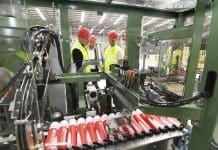Briggs & Stratton outline the important roles of battery management systems (BMS) in health & safety and how rugged testing, as well as battery pack design, can help provide a dual layer of protection
The market share of cordless battery powered equipment is rising as it is increasingly favoured over its petrol engine counterpart. There are several factors contributing to this trend from improvements to the user’s experience during operation to the benefits that come with a battery’s design.
For example, the battery management system (BMS) found in premium Lithium-ion batteries plays a crucial role in protecting the health and safety of both the user and the battery itself, ultimately reducing risk. Attached to the battery within the battery casing, a BMS is constantly able to run diagnostics on the internal mechanisms of a battery. Data can be recorded and relayed to the user on different elements including temperature, charging speed, and charge status. Combined the statistics collated by the BMS can ensure the safety of the battery for the user and protect the battery health.
Why use battery power in construction equipment?
Historically, petrol and mains-powered machinery has been the fuel of choice in the construction industry as there has been no viable challenger to the status quo. However, recently there has been a significant shift in preference across the construction sector as Lithium-ion battery-powered machinery gains pace as the choice of power worldwide. This shift has occurred for several reasons which can be attributed to three categories: noise; vibration; and emissions.
Noise pollution
The World Health Organisation considers noise to be second only to air quality as the largest environmental cause of health problems, particularly prolonged exposure. Not only this, but continual noise can impact concentration and make it harder to hear directions or warnings leading to more on-site accidents.
Depending on the type of equipment, batteries can create a near silent operating environment. The reduction of noise helps to support the user’s experience by eliminating the need for hearing protection whilst simultaneously reducing the noise impact on the local surroundings. The lower noise levels of battery powered equipment also means that work can be performed during ‘off hours’ in quiet or sensitive environments like hospitals, elder care facilities, or residences. Petrol powered equipment is likely to be prohibited in these areas due to the vast noise levels associated with such equipment. The added noise reduces the operating hours that can be used on site, particular in the early mornings.
Vibration
Whilst there is often a significant reduction in sound pressure in decibels when using battery-powered equipment, there is also likely to be a reduction in harsh operation of the equipment. In general, battery powered outdoor power equipment vibrates at a decreased level when compared to petrol powered equivalents. This is partly because cordless battery-powered machines do not require a combustion engine to deliver the same productivity. By switching to battery power, user experience can be enhanced as the vibration has less of an impact on the user. This enables the user to work more comfortably and for longer periods of time, thus improving productivity.
Emissions
Globally, the construction industry is responsible for 11% of the energy-related carbon emissions. The advantage of switching to battery power is that it creates no emissions at the point-of-use. This not only supports the growing desire for greener work but allows operators to use different pieces of equipment where it was not previously possible, such as indoors and in confined spaces.
Battery testing and design
Equipment that is used on construction sites must be able to withstand the harsh elements that come hand in hand with the industry. For this reason, batteries must go through rigorous modelling and testing protocols, including impact and vibration, to ensure that the battery performs under the demanding conditions needed for construction equipment. Vanguard batteries are specifically designed, from the ground up, to be used in commercial applications that have high vibration, impact, temperature shocks, and environmental exposure requirements.
When it comes to the design of the Vanguard battery, it starts with rugged construction: from the heavy Aluminium base to the internal structural supports, the battery is designed to withstand harsh outdoor use. The electrical componentry is fully enclosed to protect from impact and dust & water ingress, all while allowing critical venting for the battery cells. Lastly, within the battery pack, the supporting matrix for the cells, along with the heavy-duty busbars, connections, and contactors all result in a pack that can withstand the physical conditions while providing long-lasting, powerful performance.
In addition, Briggs & Stratton’s Power Application Centre has experienced Application Engineers who model, build, and test actual customer products to provide real-world development support and validation.
What role does the BMS play in battery health & safety?
The Battery Management System (BMS) is the brains that control all the functions of the battery. At its most basic, it evaluates the battery in relation to the equipment or charger; only allowing the flow of energy when properly connected and when environmental conditions and charge/discharge parameters are met. Thermistors on each cell module constantly monitor individual cell and pack temperatures, and the BMS logic will prevent exceeding safe limits for charging or discharging the battery. Therefore, any anomalies will be automatically adjusted to maintain optimum performance.
The BMS Power Map governs all the rules and boundaries for safe, long-life battery operation. By optimising the charge/discharge rates based on ambient and pack temperature, state-of-charge (SoC) and state-of-health (SoH), the BMS keeps the pack from operating in fringe areas – where Li-ion battery life is most compromised. It is the well-thought-out engineering and design principles that mitigate many of the risks that are associated with battery power. This frees the user from having to concern themselves and manually monitor such elements.
To summarise, Briggs & Stratton’s Vanguard batteries are not just a bundle of cells in an enclosure, they are engineered specifically to keep commercial users productive and safe. Whilst many elements in a Vanguard battery are hidden from view, they are constantly monitoring a multitude of factors to keep the user safe and the battery healthy for long, reliable life. As a result, many large OEM’s are preparing for a sharp rise in the use of electric construction equipment due to the social, environmental, health and safety benefits that come with their use.







![[VIDEO] World’s largest crane lifts dome at Hinkley Point C The world's largest crane, Big Carl, lifting the dome into place at Hinckley Point C's Unit 2](https://www.pbctoday.co.uk/news/wp-content/uploads/2025/07/104593-218x150.jpg)







